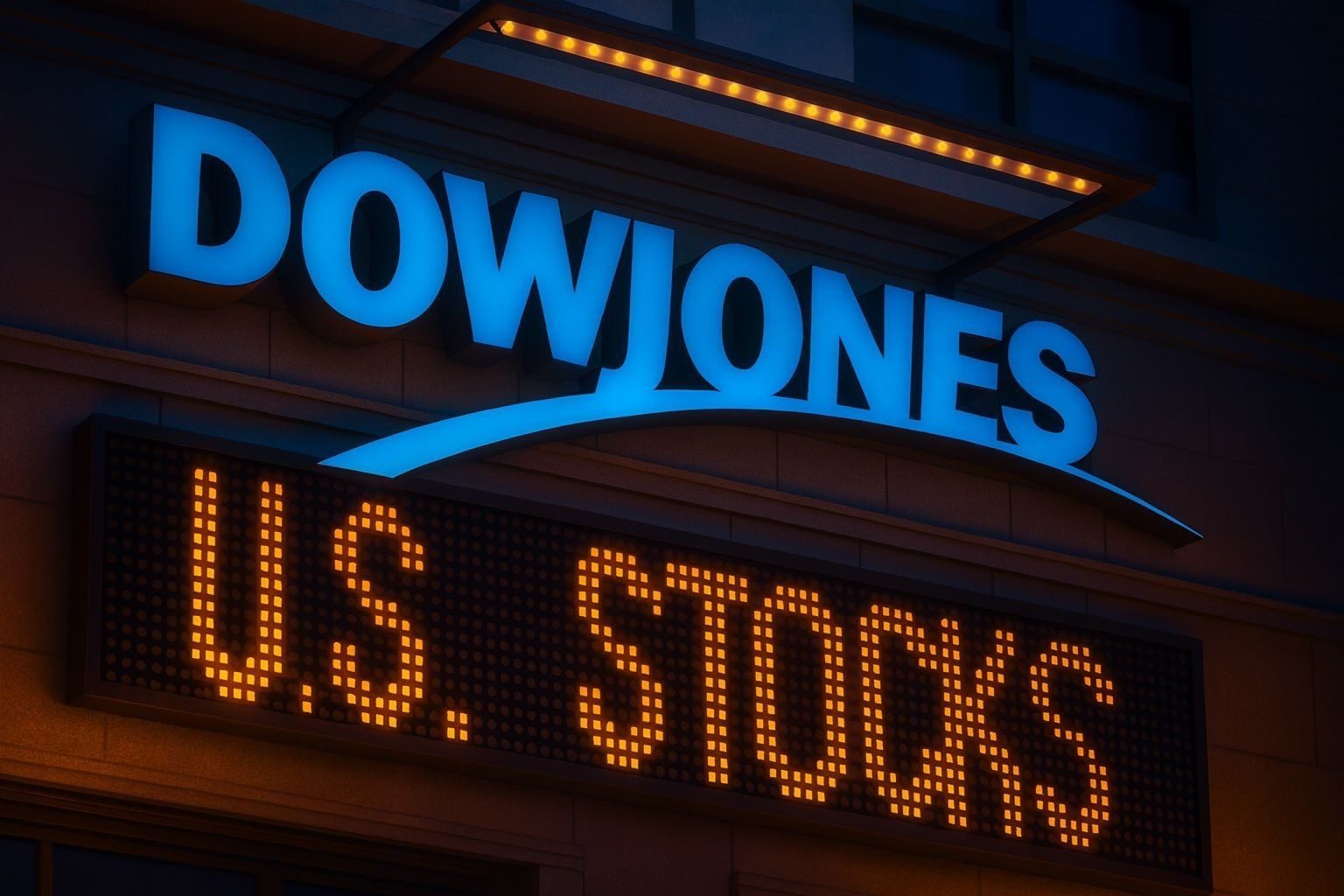U.S. stocks kicked off Thanksgiving week with a powerful rebound on Monday as rate‑cut optimism and a fresh wave of enthusiasm for artificial intelligence (AI) sent major indexes sharply higher. The Dow Jones Industrial Average — the blue‑chip Dow 30 — closed around 46,545, up about 300 points (0.65%), extending Friday’s 493‑point surge and clawing back more of November’s tech‑driven losses. [1]
The broader market rallied even harder. The S&P 500 finished up roughly 1.65% at 6,711.80, while the Nasdaq Composite jumped about 2.7% to 22,874.95, capping one of the strongest two‑day stretches for tech and AI stocks this month. [2]
Behind the move: investors are increasingly convinced the Federal Reserve will deliver a quarter‑point rate cut in December, and they piled back into growth and AI names that had been hit during recent volatility. Fed funds futures now imply roughly a 79–80% probability of a December cut, up from just over 40% a week ago, after dovish remarks from Fed Governor Christopher Waller and New York Fed President John Williams. [3]
Dow 30 today: key numbers at the close
- Dow Jones Industrial Average (Dow 30):
- Close: ~46,545
- Move: +299.92 points (+0.65%) [4]
- Friday’s close (November 21):
- Dow: 46,245.41, up 493.15 points (≈1.1%), with 25 of 30 components finishing higher. [5]
Taken together, the Dow has risen almost 800 points across two sessions, a roughly 1.7% two‑day rebound from last week’s AI‑driven slump and sharp intraday whipsaws. [6]
- S&P 500: up about 1.65% to 6,711.80
- Nasdaq Composite: up 2.70% to 22,874.95 [7]
In other words: while the Nasdaq remains the focal point of the AI trade, the Dow 30 is participating fully in the relief rally — just with its characteristic, more old‑economy flavor.
Why the Dow 30 is rising: rate‑cut hopes vs. valuation fears
Fed optimism takes center stage
The dominant story on Wall Street today is monetary policy, not earnings. Investors are betting the Fed will deliver its third and likely final rate cut of 2025 at the December meeting, after a spate of delayed economic data showed signs of labor‑market cooling alongside still‑elevated inflation. [8]
According to CME’s FedWatch tool, markets now price in roughly 79–80% odds that the Fed trims rates by 25 basis points in December, versus around 42% just a week ago. [9]
Dovish comments from:
- Christopher Waller (Fed Governor) and
- John Williams (New York Fed President)
reinforced the idea that policy is “modestly restrictive” and could be nudged closer to neutral in the near term — exactly what equity investors wanted to hear after several brutal tech‑led selloffs earlier in November. [10]
Lingering worries haven’t disappeared
Even as stocks rallied, valuation anxiety is still in the background, especially around AI‑linked megacaps. Market commentary today repeatedly referenced the risk of an “AI bubble” and the fact that November has featured some of the wildest intraday swings in years, including a roughly 1,100‑point high‑to‑low reversal in the Dow on November 20when an early Nvidia‑led spike flipped into a broad selloff. [11]
Monday’s gains, then, look less like blind euphoria and more like a “relief rally”: traders breathing easier that the Fed is still leaning dovish, even as they remain wary of overstretched tech valuations. [12]
AI and Big Tech lead the charge — and pull the Dow 30 along
Today’s market again revolved around the “Magnificent Seven” and AI‑exposed names:
- Alphabet (Google’s parent) climbed around 5–6% after fresh praise for its latest Gemini AI model, making it one of the single biggest contributors to the S&P 500’s gain. [13]
- Nvidia, now a member of the Dow 30, rose roughly 1.5–1.8%, recovering part of last week’s drop that followed blockbuster earnings but renewed bubble fears. [14]
- Tesla jumped about 6–7% after CEO Elon Musk talked up the company’s long‑term ambition in AI chips, further fueling speculative enthusiasm. [15]
- A broader semiconductor index leapt more than 4%, and communication‑services stocks — home to many digital and media giants — gained around 3%, the best‑performing sector in the S&P 500. [16]
Although the Nasdaq benefits most from this tech stampede, the Dow now has meaningful AI and cloud exposure via:
- Nvidia (NVDA) – added to the Dow in November 2024, replacing Intel [17]
- Microsoft (MSFT) – the index’s heaviest‑weighted component
- Amazon (AMZN) – added in February 2024 [18]
- Apple (AAPL) and Salesforce (CRM)
That cluster of growth names helped the Dow 30 ride today’s AI updraft even though the index is still dominated by more mature, lower‑volatility companies. [19]
Today’s Dow 30 winners and laggards
While the Dow closed solidly higher, performance within the index was far from uniform. Midday data and closing sector moves highlight a classic “risk‑on” pattern:
Stand‑out winners
- Merck (MRK) – In early trading, the pharmaceutical giant was the single best‑performing Dow component, up about 3.1%, a notable move for a large, defensive healthcare stock that has otherwise been flat this year. [20]
- Nvidia (NVDA) – Gained around 1.5–1.8%, adding positive points to the index after being a key source of volatility last week. [21]
- Amazon (AMZN) – Traded roughly 1.7% higher by midday as investors rotated back into high‑growth consumer and cloud names. [22]
- Other growth‑tilted Dow stocks such as Microsoft, Salesforce and Visa also benefited indirectly from the AI and rate‑cut narrative, though detailed component data for the close is still filtering through late‑day reports. (Their sectors — technology and financials — finished solidly in the green.) [23]
Notable laggards
- Procter & Gamble (PG) – At midday, PG was the worst Dow performer, down about 1.4%, even as the broader market rallied. Investors often trim staples to fund moves into higher‑beta names when risk appetite improves. [24]
- Honeywell (HON) – Traded about 1% lower earlier in the session, bucking the broader industrials strength and weighing slightly on the price‑weighted index. [25]
- Consumer staples and energy more broadly underperformed: Reuters notes those sectors finished in the red even as cyclical and growth sectors surged, a classic sign of money rotating out of defensives and into riskier corners of the market. [26]
Net‑net, 25–26 of the 30 Dow components were positive at various points during the session, but a handful of consumer‑staples and energy names capped the index’s gains compared with the tech‑heavy Nasdaq. [27]
A wild November sets the backdrop for today’s rebound
Today’s rally doesn’t come out of nowhere; it’s part of a roller‑coaster November for the Dow 30.
Analysts have described the Dow this month as a “barometer of a market caught between conflicting forces” — optimism about potential rate cuts versus anxiety over sky‑high AI valuations and an uneven economic picture. [28]
Key moments in the recent saga:
- Mid‑month surge: On November 11, the Dow jumped more than 500 points (~1.2%) to a short‑lived record as hopes rose for an end to a federal government shutdown, with healthcare and other defensive names leading. [29]
- Sharp reversals: By November 18–20, the tone flipped. A series of AI‑related selloffs — especially around Nvidia and other chip names — triggered back‑to‑back declines and culminated in that dramatic 1,100‑point intraday swing on November 20, when a big opening rally reversed into a 0.8% loss by the close. [30]
- Friday’s comeback: On November 21, the Dow rebounded 493 points (1.1%) to 46,245.41 after John Williams signaled he could support another rate cut “in the near term,” helping markets look past concerns about delayed government data and AI valuations. [31]
Monday’s advance to about 46,545 effectively extends that Friday rebound and leaves the Dow modestly positive for the month, though StatMuse data shows the index is roughly flat over the last six weeks, highlighting how volatile the ride has been. [32]
What Monday’s move means for Dow 30 investors
1. Bulls are back in control — for now
Two strong sessions in a row suggest bulls still have the upper hand, especially ahead of a historically bullish Thanksgiving‑to‑year‑end window if rate‑cut hopes prove correct. A confirmed December cut would lower borrowing costs for rate‑sensitive Dow components in industrials, financials and consumer discretionary, potentially boosting 2026 earnings expectations. [33]
2. Volatility is “the new normal”
Both the AP and independent market commentators stress that sharp day‑to‑day and even hour‑to‑hour swings are likely to persist as investors juggle:
- AI enthusiasm vs. bubble fears
- Mixed messages from economic data
- Political and policy uncertainty, including tariffs and a recent government shutdown that delayed key U.S. statistics [34]
For Dow 30 watchers, that means big intraday moves in a handful of high‑priced names — like Nvidia, Caterpillar, Microsoft or Sherwin‑Williams — can still dominate index performance even on otherwise quiet news days. [35]
3. What to watch next this week
Several catalysts could sway the Dow 30 through the rest of the shortened holiday week: [36]
- Economic data releases: Delayed reports on retail sales, producer prices and durable‑goods orders are due in coming days, along with housing and confidence indicators. Any upside surprise on inflation could cool rate‑cut hopes; weaker growth data could reignite recession fears.
- Fed communication: Markets will parse every speech and interview from Fed officials for hints about December. A more hawkish tone could quickly unwind some of today’s gains.
- Holiday spending signals: Thanksgiving, Black Friday and Cyber Monday provide an early read on the health of the U.S. consumer — critical for Dow retailers and consumer giants like Walmart, McDonald’s and Amazon.
- Ongoing AI news flow: Updates from Alphabet, Nvidia and other AI leaders will continue to dictate sentiment around the AI trade and, by extension, a slice of the Dow 30.
Bottom line
The Dow 30 today (November 24, 2025) closed solidly higher, up about 300 points, as Wall Street embraced the idea of a December Fed rate cut and rushed back into AI‑heavy tech names. Under the surface, the rally favored growth and cyclicals — from Nvidia and Amazon to Merck — while some defensive staples and energy stocks lagged. [37]
For investors, the message is nuanced: the bullish narrative is intact, but it’s built on a delicate foundation of central‑bank optimism and AI enthusiasm in a market that has shown it can swing from euphoria to fear within a single session. Heading into Thanksgiving and the final stretch of 2025, the Dow 30 looks positioned for further gains — but only if the data and the Fed cooperate.
References
1. www.reuters.com, 2. www.reuters.com, 3. www.reuters.com, 4. www.reuters.com, 5. www.nasdaq.com, 6. markets.financialcontent.com, 7. www.reuters.com, 8. www.reuters.com, 9. www.reuters.com, 10. www.reuters.com, 11. markets.financialcontent.com, 12. www.reuters.com, 13. virginiabusiness.com, 14. virginiabusiness.com, 15. www.reuters.com, 16. www.reuters.com, 17. en.wikipedia.org, 18. en.wikipedia.org, 19. www.kiplinger.com, 20. www.nasdaq.com, 21. virginiabusiness.com, 22. www.nasdaq.com, 23. www.reuters.com, 24. www.nasdaq.com, 25. www.nasdaq.com, 26. www.reuters.com, 27. www.reuters.com, 28. markets.financialcontent.com, 29. markets.financialcontent.com, 30. markets.financialcontent.com, 31. www.nasdaq.com, 32. www.statmuse.com, 33. www.reuters.com, 34. virginiabusiness.com, 35. www.marketwatch.com, 36. www.reuters.com, 37. www.reuters.com







